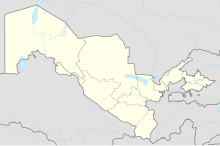Fayaz-Tepa
Coordinates: 37 ° 17 ′ 10 ″ N , 67 ° 11 ′ 16.9 ″ E
Fayaz-Tepa was a Buddhist monastery on a hill near the city of Termiz in what is now Uzbekistan .
history
The complex from the 1st century was one of the centers of Buddhist culture in the Kushana Empire in Central Asia. In the 3rd century Kushana was conquered by the Sassanids , which ended the phase of Buddhist supremacy in the region and its religious centers lost importance.
In 1963, the building complex was rediscovered by the archaeologist L. Albaum during investigations of the comparable Buddhist complex Kara-Tepa , about 1 km away . From 2000 to 2004, a project funded by Japan protected the soil from further erosion and built visitor facilities. The cost was approximately $ 700,000 .
investment
The facility is 34 meters long and 113 meters wide and can be divided into three areas, each of which comprises a similarly large area: a living area, a cooking and dining area and the religious buildings of the complex. Based on the size of the facility, it is believed that no more than 20 monks lived permanently in Fayaz-Tepa. The most striking building in the complex is a 10-meter-high stupa from the 1st century. Illustrations on the religious buildings show a variety of Buddha images. Some Buddhist sculptures from the 1st to 3rd centuries have also been preserved. One of them - Buddha under the Bodhi tree with two monks on his hand - is now on display in the Uzbek History Museum. In addition, coins and fragments of ceramics with inscriptions in the Kharoshthi script and the Brahmi script were found in the complex . A foundation for another building that was never completed was discovered near the complex.
Buddhist complexes comparable to Kara-Tepa and Surmala have been discovered near the city of Termiz .
Individual evidence
- ↑ Ms Suchandana Chatterjee: Trans Himalayan Buddhism: Re-connecting Spaces, Sharing Concerns .
- ↑ Project financed by Japan: Fayaz-Tepa Buddhist Remains. Retrieved November 12, 2018 .
- ^ The Buddhist complex of Fayaz-Tepa :: Historical monuments of Termez and the Surkandarya region. Retrieved November 12, 2018 .
- ^ The Buddhist complex of Fayaz-Tepa :: Historical monuments of Termez and the Surkandarya region. Retrieved November 12, 2018 .

